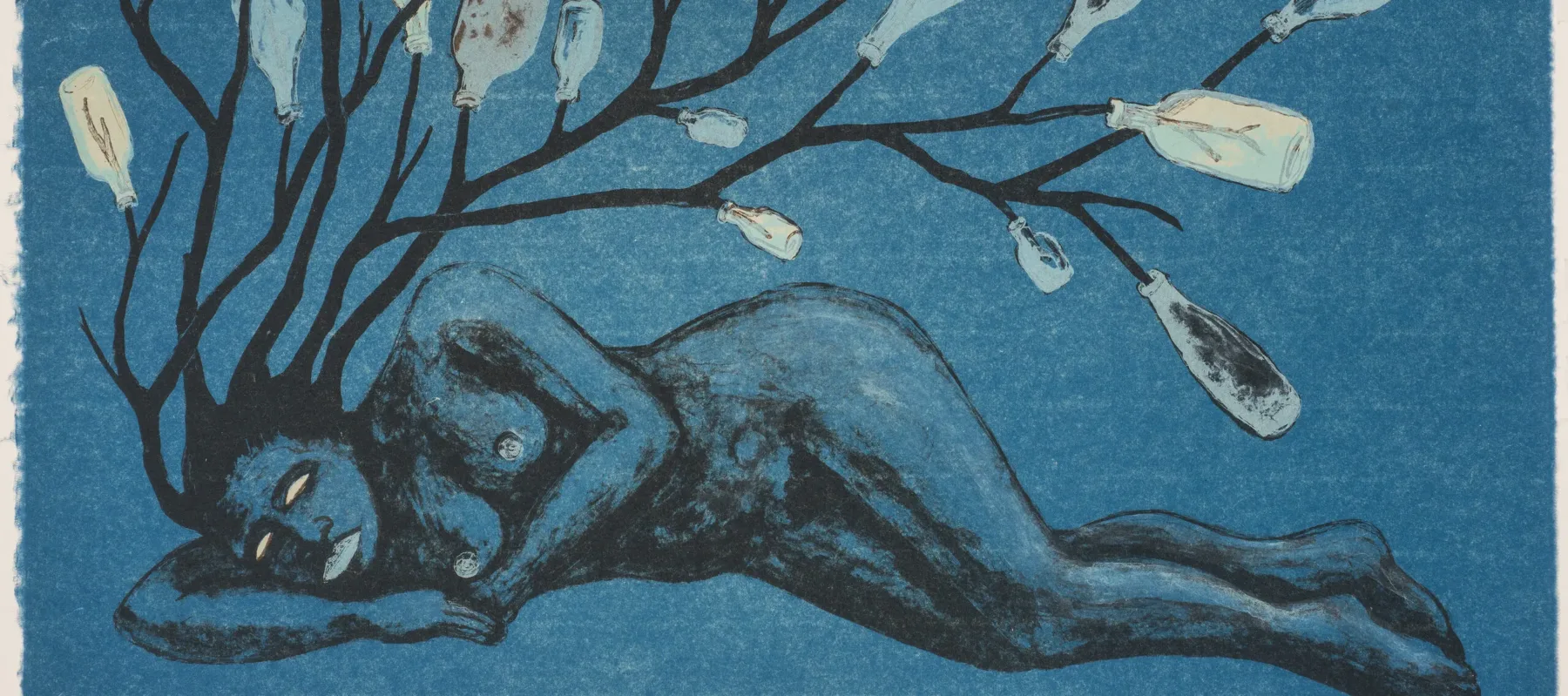WASHINGTON—The National Museum of Women in the Arts (NMWA) presents Alison Saar In Print, on view June 10–Oct. 2, 2016. Inspired by her sculptural practice, Alison Saar (b. 1956, Los Angeles) uses dynamic printmaking techniques characterized by bold forms and striking colors to explore themes of feminine, racial and cultural identity. NMWA’s collection includes an array of Saar’s prints from throughout her career. This focus exhibition of 16 works samples the museum’s Saar holdings and also features related sculptures and prints from private collections.
Whether in two dimensions or three, the figures in Saar’s works are rich in textural detail and meaning. She grew up surrounded by art, thanks to her mother, the acclaimed collagist and assemblage artist Betye Saar, and her father, Richard, a painter and art conservator who ran a restoration shop. She developed her own artistic practice, creating sculptures made from found objects, and also began printmaking.
Saar’s prints often relate closely to her sculptures and assemblages, which are made from a wide range of materials. Her use of color infuses her subjects with a powerful energy. Against her prints’ spare backgrounds, the figures resemble freestanding sculptures, becoming potent distillations of Saar’s three-dimensional forms. Saar often portrays people interacting with evocative objects such as snakes, frying pans and knives, which allude to a range of myth, lore and legend. She also critiques cultural stereotypes, depicting figures that transform into brooms or consume cotton.
“Experienced in numerous printmaking techniques, Saar considers herself primarily a woodcarver, feeling that wood best renders her ‘mark,’” said Curatorial Assistant Stephanie Midon. “She typically crafts her print images after completing related sculptures, using printmaking as a mode to expand on themes of identity, womanhood, history and culture.”
Her prints are thematically complex, drawing upon her deep interest in the African diaspora and issues of gender, race, culture and history. In the Mirror, Mirror prints,a female figure in a sheer garment stands with her back to the viewer, her face only visible via its reflection in a cast-iron skillet. The image confronts circumscribed gender roles and standards of beauty.
Saar says that much of her work may be interpreted as autobiographical, and nearly all of her sculptures and prints explore aspects of the female experience. The figure in Sweeping Beauty (1997) appears to morph into a utilitarian object, referencing the conventional role of women working at household tasks, while also suggesting feminine strength. Her body is inverted so that her hair brushes along the bottom edge of the print like a broom. Saar believes that women often exert a calming power within their family, sweeping away troubles and distractions.
Shorn (2014) features another strong female figure: a woman stands defiant, with her hair—cut by a shard of glass—pooled around her feet. Shaving one’s hair is a rite of passage in many cultures, and it may also be interpreted as a gesture of mourning.
In the print Pallor Tricks (2004)and related sculpture Pallor Trick (2013), Saar deftly alludes to the subjects of racial identity and societal definitions of beauty. The titles feature a play on words, referring to the notion of a parlor trick, an illusion meant to entertain guests. In each work, the female figure stands with a white sheet draped over her head as if playing a game of hide and seek. Saar plays a trick of her own, using the word “pallor” to draw attention to the translucent white sheet that partially veils the figure’s dark skin.
Saar includes many mythical references in her images, reflecting her interest in a range of cultures. Even her color palette is influenced by hues representative of spirits, such as red for Shango, the Yoruba god of thunder, or blue for Yemaya, the Yoruba goddess of the sea.
Snake Man (1994) combines Afro-Caribbean and Christian symbolism, showing a shaman-like figure holding a snake between his teeth. Serpent imagery appears across many cultures and recurs throughout Saar’s work; here it may represent both good and evil as it balances between the figure’s teeth. Saar completed this print after one of her early sculptures, Snake Charmer (1985), noting that the figure was inspired by a gypsy she met. She created the sculpture from found objects and similarly used a discarded, cracked piece of linoleum to print Snake Man, giving the figure a dynamic, textured pattern.
Expanding on the ideas and subjects of her sculptures, Alison Saar’s prints are rich with symbolism and layered meaning. She brings social inequities as well as human virtues to the forefront by combining subtle wit with a powerful aesthetic defined by color, texture and evocative details.
Alison Saar In Print, presented in the Teresa Lozano Long Gallery of the National Museum of Women in the Arts, is organized by the museum and generously supported by the Louis J. Kuriansky Foundation, Inc., and the members of NMWA.
National Museum of Women in the Arts
The National Museum of Women in the Arts (NMWA) is the world’s only major museum solely dedicated to celebrating the creative contributions of women. The museum champions women through the arts by collecting, exhibiting, researching and creating programs that advocate for equity and shine a light on excellence. NMWA highlights remarkable women artists of the past while also promoting the best women artists working today. The museum’s collection includes over 4,700 works by more than 1,000 women artists from the 16th century to the present, including Mary Cassatt, Frida Kahlo, Alma Thomas, Lee Krasner, Louise Bourgeois, Chakaia Booker and Nan Goldin.
NMWA is located at 1250 New York Avenue, NW, Washington, D.C., in a landmark building near the White House. It is open Monday–Saturday, 10 a.m.–5 p.m. and Sunday, noon–5 p.m. For information, call 202-783-5000 or visit nmwa.org. Admission is $10 for adults, $8 for visitors 65 and over and students, and free for NMWA members and youths 18 and under. Free Community Days take place on the first Sunday of each month. For more information about NMWA, visit nmwa.org, Broad Strokes Blog, Facebook, Twitter or Instagram.
